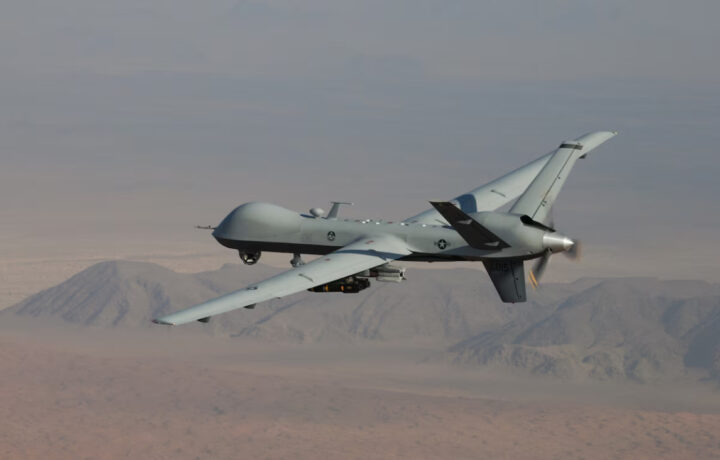The United States Air Force’s MQ-9 “Reaper” – designed to be a follow-up to the MQ-1 Predator – currently serves primarily in an intelligence, surveillance, and reconnaissance (ISR) role, while its secondary role is to strike dynamic execution targets. In the latter role, it can carry a great deal of ordnance, which allows it to fulfill the “hunter” component of a hunter-killer drone. Reapers can carry eight Hellfire missiles, double the Predator, while the MQ-9 can also carry up to 500 pounds of bombs.
Even as the U.S. Air Force seeks to develop more autonomous and capable drones, the MQ-9 has continued to be updated and enhanced.
Last month, it was put to a series of unique tests – that included remote-controlled flight from nearly halfway across the country, while it was also employed in an exercise from a remote airstrip.
From California to Tennessee
In early June, the Tennessee Air National Guard’s 118th Wing remotely operated an MQ-9 from California to Tennessee without ground crews or the support facilities usually deployed for line-of-sight taxiing, takeoff, and landing.
The test was conducted as part of the exercise Whiskey Fury, which was designed around the Air Force’s new Agile Combat Employment model. Members from the 118th Operations Group piloted the MQ-9 to a successful takeoff and landing. The service said the key to the success of the exercise was a state-of-the-art technology called Satellite Launch and Recovery (SLR), which fundamentally changes how MQ-9s are flown and supported.
“What SLR does is take forward-deployed crews out of the equation,” explained Lt. Col. John Woods, assistant director of operations, 118th Operations Support Squadron.
The new technology could significantly reduce the need for equipment and support, and it could be employed on larger aircraft.
“The airplane is still being flown through the satellite, but based on an auto takeoff and landing profile we’ve built into it that basically allows the aircraft to go and land on its own,” Woods continued, adding, “The fact that the MQ-9 touched down the first time as smoothly as it did is a credit to everybody in the operations group as well as the wing. Our targeting group came up with the coordinates. Our mission support group got the equipment from California.”
Operating From a Dirt Runway
The Air Force also conducted the first dirt landing of a Reaper at the Nine Mile Training Center, a remote dirt strip in West Texas, south of Fort Stockton. The facility is one of the largest private armed forces training centers in the country, and the expansive terrain is employed to provide privacy from prying eyes.
Though the operation was conducted in secret, the Air Force Special Operations Command has touted the mission’s success, as members from the 2nd Special Operations Squadron, 727th Special Operations Aircraft Maintenance Squadron, and 311th Special Operations Intelligence Squadron teamed up with Airmen from the 26th Special Tactics Squadron out of Cannon Air Force Base (AFB), New Mexico. The team effort resulted in a successful landing of the MQ-9 on the dirt landing zone.
The ability to work from remote airstrips anywhere in the world could further enhance the capabilities of unmanned aerial systems (UAS). This could make it uniquely qualified to conduct irregular warfare operations in support of combatant commander objectives.
Able to Operate Around the Globe
These recent tests come following last October’s “Emerald Flag” exercise at Eglin Air Force Base (AFB), FL, where the Air Force Special Operations Command’s Remotely Piloted Aircraft enterprise used the large-force event to demonstrate the Agile Combat Employment’s ability to operate the MQ-9 Reaper aircraft from anywhere in the world.
Members of the Air Force Reserve’s 2nd SOS and their active-duty counterparts in the 65th SOS integrated with MC-130H Combat Talon II and leveraged the wide range of capabilities presented by Mission Support Team specialists, both from Hurlburt Field. The training exercises focused largely on MQ-9 aircraft recovery operations, where MST members set up security and provided a communications station on the “deployed” airfield in support of the Reaper for the exercise.
Russia Doesn’t Like the Reaper
The U.S. Air Force’s MQ-9 has been in the news for other reasons of late – and it was on Wednesday that Russian aircraft were reported to have “harassed” the hunter-killer drones that were conducting a mission against ISIS targets in Syria. Three Russian jet fighters conducted close flights near the drones.
“Russian military aircraft engaged in unsafe and unprofessional behavior while interacting with U.S. aircraft in Syria,” United States Air Force Lt. Gen. Alexus Grynkewic, command of the Ninth Air Force and the Combined Forces Air Component for U.S. Central Command, told reporters. “Against established norms and protocols, the Russian jets dropped multiple parachute flares in front of the drones, forcing our aircraft to conduct evasive maneuvers.”
This was just the most recent incident involving Russian pilots and the MQ-9.
It was in March that a Russian Sukhoi Su-27 (NATO reporting name “Flanker”) jet fighter struck a United States Air Force MQ-9 Reaper over the Black Sea. The collision damaged the propeller of the U.S. drone, which forced the operators to bring down the Reaper in international waters. The U.S. Air Force also labeled the aggressive actions by Russian aircrew “dangerous,” and warned that it could lead to miscalculation and unintended escalation.



